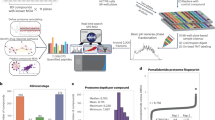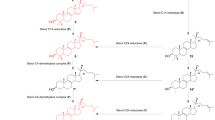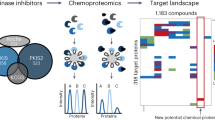Abstract
Oxysterols (OHCs) are hydroxylated cholesterol metabolites that play ubiquitous roles in health and disease. Due to the non-covalent nature of their interactions and their unique partitioning in membranes, the analysis of live-cell, proteome-wide interactions of OHCs remains an unmet challenge. Here, we present a structurally precise chemoproteomics probe for the biologically active molecule 20(S)-hydroxycholesterol (20(S)-OHC) and provide a map of its proteome-wide targets in the membranes of living cells. Our target catalog consolidates diverse OHC ontologies and demonstrates that OHC-interacting proteins cluster with specific processes in immune response and cancer. Competition experiments reveal that 20(S)-OHC is a chemo-, regio- and stereoselective ligand for the protein transmembrane protein 97 (Tmem97/the σ2 receptor), enabling us to reconstruct the 20(S)-OHC–Tmem97 binding site. Our results demonstrate that multiplexed, quantitative analysis of cellular target engagement can expose new dimensions of metabolite activity and identify actionable targets for molecular therapy.

This is a preview of subscription content, access via your institution
Access options
Access Nature and 54 other Nature Portfolio journals
Get Nature+, our best-value online-access subscription
$29.99 / 30 days
cancel any time
Subscribe to this journal
Receive 12 print issues and online access
$259.00 per year
only $21.58 per issue
Buy this article
- Purchase on Springer Link
- Instant access to full article PDF
Prices may be subject to local taxes which are calculated during checkout






Similar content being viewed by others
Data availability
Raw MS data for this study have been deposited to the ProteomeXchange Consortium via the PRIDE partner repository with the dataset identifier PXD027787. Source data are provided with this paper.
Code availability
Code used for MS data analysis is available on GitHub at https://github.com/alex-ondrus/mass_spec_data_imputation.
References
Maxfield, F. R. & van Meer, G. Cholesterol, the central lipid of mammalian cells. Curr. Opin. Cell Biol. 22, 422–429 (2010).
Miller, W. L. & Auchus, R. J. The molecular biology, biochemistry, and physiology of human steroidogenesis and its disorders. Endocr. Rev. 32, 81–151 (2011).
Schroepfer, G. J. Oxysterols: modulators of cholesterol metabolism and other processes. Physiol. Rev. 80, 361–554 (2000).
Vesa, M., Olkkonen, V. M., Béaslas, O. & Nissilä, E. Oxysterols and their cellular effectors. Biomolecules 2, 76–103 (2012).
Wang, Y., Yutuc, E. & Griffiths, W. J. Cholesterol metabolism pathways—are the intermediates more important than the products? FEBS J. 288, 3727–3745 (2021).
Bielska, A. A., Schlesinger, P., Covey, D. F. & Ory, D. S. Oxysterols as non-genomic regulators of cholesterol homeostasis. Trends Endocrinol. Metab. 23, 99–106 (2012).
Nachtergaele, S. et al. Oxysterols are allosteric activators of the oncoprotein Smoothened. Nat. Chem. Biol. 8, 211–220 (2012).
Nedelcu, D., Liu, J., Xu, Y., Jao, C. & Salic, A. Oxysterol binding to the extracellular domain of Smoothened in Hedgehog signaling. Nat. Chem. Biol. 9, 557–564 (2013).
Zhang, T. & Ondrus, A. E. Structure, bonding, and photoaffinity labeling applications of dialkyldiazirines. Synlett 32, 1053–1059 (2021).
Li, T. et al. Ion mobility-based sterolomics reveals spatially and temporally distinctive sterol lipids in the mouse brain. Nat. Commun. 12, 4343 (2021).
Lin, Y. Y., Welch, M. & Lieberman, S. The detection of 20(S)-hydroxycholesterol in extracts of rat brains and human placenta by a gas chromatograph/mass spectrometry technique. J. Steroid Biochem. Mol. Biol. 85, 57–61 (2003).
Johnson, J. S. et al. Novel oxysterols have pro-osteogenic and anti-adipogenic effects in vitro and induce spinal fusion in vivo. J. Cell. Biochem. 112, 1673–1684 (2011).
Pratt, H. P., Keith, J. & Chakraborty, J. Membrane sterols and the development of the preimplantation mouse embryo. J. Embryol. Exp. Morphol. 60, 303–319 (1980).
Jao, C. Y. et al. Bioorthogonal probes for imaging sterols in cells. ChemBioChem 16, 611–617 (2015).
Makino, T., Shibata, K., Rohrer, D. C. & Osawa, Y. Steroid conformations in solid and solution: stereoselectivity of Grignard addition to 20-oxo steroids. J. Org. Chem. 43, 276–280 (1978).
Tran, U., Zhang, G. C., Eom, R., Billingsley, K. L. & Ondrus, A. E. Small molecule intervention in a protein kinase C–Gli transcription factor axis. ACS Chem. Biol. 15, 1321–1327 (2020).
Ohgane, K., Karaki, F., Dodo, K. & Hashimoto, Y. Discovery of oxysterol-derived pharmacological chaperones for NPC1: implication for the existence of second sterol-binding site. Chem. Biol. 20, 391–402 (2013).
Okamoto, Y., Ninomiya, H., Miwa, S. & Masaki, T. Cholesterol oxidation switches the internalization pathway of endothelin receptor type A from caveolae to clathrin-coated pits in Chinese hamster ovary cells. J. Biol. Chem. 275, 6439–6446 (2000).
Budelier, M. M. et al. Photoaffinity labeling with cholesterol analogues precisely maps a cholesterol-binding site in voltage-dependent anion channel-1. J. Biol. Chem. 292, 9294–9304 (2017).
Schmidt, H. R. & Kruse, A. C. The molecular function of σ receptors: past, present, and future. Trends Pharmacol. Sci. 40, 636–654 (2019).
Goo, Y.-H., Son, S.-H., Kreienberg, P. B. & Paul, A. Novel lipid droplet-associated serine hydrolase regulates macrophage cholesterol mobilization. Arter. Thromb. Vasc. Biol. 34, 386–396 (2018).
Vogel‐Bindel, U., Bentley, P. & Oesch, F. Endogenous role of microsomal epoxide hydrolase. Eur. J. Biochem. 126, 425–431 (1982).
Schaafhausen, A., Rost, S., Oldenburg, J. & Müller, C. Identification of VKORC1 interaction partners by split-ubiquitin system and coimmunoprecipitation. Thromb. Haemost. 105, 285–294 (2011).
Suzuki, J., Imanishi, E. & Nagata, S. Xkr8 phospholipid scrambling complex in apoptotic phosphatidylserine exposure. Proc. Natl Acad. Sci. USA 113, 9509–9514 (2016).
Fenech, E. J. et al. Interaction mapping of endoplasmic reticulum ubiquitin ligases identifies modulators of innate immune signalling. eLife 9, e57306 (2020).
Subramanian, A. et al. Gene set enrichment analysis: a knowledge-based approach for interpreting genome-wide expression profiles. Proc. Natl Acad. Sci. USA 102, 15545–15550 (2005).
Peyrot, S. M. et al. Tracking the subcellular fate of 20(S)-hydroxycholesterol with click chemistry reveals a transport pathway to the Golgi. J. Biol. Chem. 289, 11095–11110 (2014).
Ridgway, N. D. 25-Hydroxycholesterol stimulates sphingomyelin synthesis in Chinese hamster ovary cells. J. Lipid Res. 36, 1345–1358 (1995).
Zidovetzki, R. & Levitan, I. Use of cyclodextrins to manipulate plasma membrane cholesterol content: evidence, misconceptions and control strategies. Biochim. Biophys. Acta 1768, 1311–1324 (2007).
Jansen, J. C. et al. TMEM199 deficiency is a disorder of Golgi homeostasis characterized by elevated aminotransferases, alkaline phosphatase, and cholesterol and abnormal glycosylation. Am. J. Hum. Genet. 98, 322–330 (2016).
Kalken, Cvan et al. Cortisol is transported by the multidrug resistance gene product P-glycoprotein. Br. J. Cancer 67, 284–289 (1993).
Prokesch, A. et al. Arxes: retrotransposed genes required for adipogenesis. Nucleic Acids Res. 39, 3224–3239 (2011).
Wierbowski, B. M. et al. Hedgehog pathway activation requires coreceptor-catalyzed, lipid-dependent relay of the Sonic Hedgehog ligand. Dev. Cell 55, 450–467 (2020).
Rone, M. B. et al. Identification of a dynamic mitochondrial protein complex driving cholesterol import, trafficking, and metabolism to steroid hormones. Mol. Endocrinol. 26, 1868–1882 (2012).
Yao, L. et al. REEP5 (receptor accessory protein 5) acts as a sarcoplasmic reticulum membrane sculptor to modulate cardiac function. J. Am. Heart Assoc. 7, e007205 (2018).
Zhou, G. L., Na, S.-Y., Niedra, R. & Seed, B. Deficits in receptor-mediated endocytosis and recycling in cells from mice with Gpr107 locus disruption. J. Cell Sci. 127, 3916–3927 (2014).
Zeng, C., Riad, A. & Mach, R. H. The biological function of σ-2 receptor/TMEM97 and its utility in PET imaging studies in cancer. Cancers 12, 1877 (2020).
Alon, A. et al. Identification of the gene that codes for the σ2 receptor. Proc. Natl Acad. Sci. USA 114, 7160–7165 (2017).
Bartz, F. et al. Identification of cholesterol-regulating genes by targeted RNAi screening. Cell Metab. 10, 63–75 (2009).
Ebrahimi-Fakhari, D. et al. Reduction of TMEM97 increases NPC1 protein levels and restores cholesterol trafficking in Niemann-pick type C1 disease cells. Hum. Mol. Genet. 25, 3588–3599 (2016).
Hulce, J. J., Cognetta, A. B., Niphakis, M. J., Tully, S. E. & Cravatt, B. F. Proteome-wide mapping of cholesterol-interacting proteins in mammalian cells. Nat. Methods 10, 259–264 (2013).
Morisaki, M., Shikita, M. & Ikekawa, N. Side-chain cleavage of cholesterol by gas chromatography-mass spectrometry in a selected ion monitoring mode. Methods Enzymol. 111, 352–364 (1985).
Moebius, F. F. et al. Histidine77, glutamic acid81, glutamic acid123, threonine126, asparagine194, and tryptophan197 of the human emopamil binding protein are required for in vivo sterol Δ8−Δ7 isomerization. Biochemistry 38, 1119–1127 (1999).
Raman, S. et al. Structure prediction for CASP8 with all-atom refinement using Rosetta. Proteins 77, 89–99 (2009).
Alon, A. et al. Crystal structures of the σ2 receptor template large-library docking for selective chemotypes active in vivo. Preprint at bioRxiv https://doi.org/10.1101/2021.04.29.441652 (2021).
Radhakrishnan, A., Ikeda, Y., Kwon, H. J., Brown, M. S. & Goldstein, J. L. Sterol-regulated transport of SREBPs from endoplasmic reticulum to Golgi: oxysterols block transport by binding to Insig. Proc. Natl Acad. Sci. USA 104, 6511–6518 (2007).
Chang, T. Y., Limanek, J. S. & Chang, C. C. Evidence indicating that inactivation of 3-hydroxy-3-methylglutaryl coenzyme A reductase by low density lipoprotein or by 25-hydroxycholesterol requires mediator protein(s) with rapid turnover rate. J. Biol. Chem. 256, 6174–6180 (1981).
Yablokov, E. O. et al. Substrate-induced modulation of protein–protein interactions within human mitochondrial cytochrome P450-dependent system. J. Steroid Biochem. Mol. Biol. 208, 105793–105799 (2021).
Alpy, F. et al. Functional characterization of the MENTAL domain. J. Biol. Chem. 280, 17945–17952 (2005).
Taipale, J. et al. Effects of oncogenic mutations in Smoothened and Patched can be reversed by cyclopamine. Nature 406, 1005–1009 (2000).
Baghirova, S., Hughes, B. G., Hendzel, M. J. & Schulz, R. Sequential fractionation and isolation of subcellular proteins from tissue or cultured cells. MethodsX 2, 440–445 (2015).
Brinkman, E. K., Chen, T., Amendola, M. & van Steensel, B. Easy quantitative assessment of genome editing by sequence trace decomposition. Nucleic Acids Res. 42, e168–e168 (2014).
Riniker, S. & Landrum, G. A. Better informed distance geometry: using what we know to improve conformation generation. J. Chem. Inf. Model. 55, 2562–2574 (2015).
Mafi, A. et al. Hedgehog proteins create a dynamic cholesterol interface. PLoS ONE 16, e0246814 (2021).
Acknowledgements
The authors thank A. Li for synthesizing 20(R)-OHC intermediates, the Beckman Institute/Caltech Flow Cytometry Cell Sorting Facility for cell sorting and A.K. Menon and F.R. Maxfield for helpful discussions. This work was funded by the Margaret Early Foundation Research Trust (A.E.O.), a John Stauffer Charitable Trust SURF Fellowship (T.Z.), a William N. Lacy SURF fellowship (S.P.) and NIH training grant NIH GM07616 (G.C.Z.). The Proteome Exploration Laboratory was supported by NIH OD010788, NIH OD020013, the Betty and Gordon Moore Foundation through grant GBMF775 and the Beckman Institute at Caltech.
Author information
Authors and Affiliations
Contributions
Y.-S.C. performed all gel- and MS-based chemoproteomics experiments, MS data processing, cloning, gene editing and coimmunoprecipitation experiments. T.Z., X.M., Y.-S.C. and G.C.Z. performed chemical synthesis. S.P. performed homology modeling and molecular docking experiments. G.C.Z. performed Shh-LIGHT2 signaling assays. A.A.O. performed MS data analysis and visualization. A.M. performed molecular dynamics simulations. B.L. participated in experimental design, provided new reagents/analytical tools and participated in data analysis. J.J.J. participated in data analysis. A.E.O., Y.-S.C., T.Z. and S.P. wrote the manuscript.
Corresponding author
Ethics declarations
Competing interests
The authors declare no competing interests.
Additional information
Peer review information Nature Chemical Biology thanks Anant Menon and other anonymous reviewer(s) for their contribution to the peer review of this work.
Publisher’s note Springer Nature remains neutral with regard to jurisdictional claims in published maps and institutional affiliations.
Extended data
Extended Data Fig. 1 Endogenous Smoothened protein is inefficiently resolubilized after acetone precipitation.
a Western blot of Smoothened protein eluted from streptavidin beads after live-cell photocrosslinking to 2, biotinylation, acetone precipitation (to remove excess biotin), and streptavidin enrichment. Analysis of precipitate removed before incubation with streptavidin resin shows that Smoothened is largely insoluble in incubation buffer (1% SDS and 1% IGEPEL CA-630 in PBS) after acetone precipitation. The experiment was repeated five times independently with similar results.
Extended Data Fig. 2 The enrichment profile of 2 is independent of quantification method and mRNA transcript abundance.
a Volcano plot of proteins enriched by 2 versus DMSO alone, performed as in Fig. 3a but quantified by label-free quantification (LFQ) instead of TMT analysis. The top 12 enriched proteins identified by TMT analysis (labeled in Fig. 3b) are highlighted in red. Data represent two biological replicates consisting of matched experiments with 2 and DMSO. Statistical significance for each protein was calculated using a two-tailed paired t-test. b Plot of enrichment values from label-free versus TMT quantification, showing a positive correlation. Statistical significance, assessed by linear regression in GraphPad Prism, is shown (R2 = 0.2725, p < 0.0001). c Plot of RNA transcript abundances in NIH-3T3 cells (ref. 16) versus enrichment of the corresponding proteins by TMT quantification, showing no significant correlation. Statistical significance, assessed by linear regression in GraphPad Prism, is shown (R2 = 0.002232, p = 0.0503).
Extended Data Fig. 3 Co-treatment with MβCD enhances 20(S)-OHC competition without altering 2-enrichment profiles.
a Streptavidin IRDye 800CW signal for biotinylated proteins in aliquots from mass spectrometry samples. MβCD reduces overall labeling, enhances competition of the probe-labeled 21 kDa band, and preserves equal intensity of non-competable bands in the presence and absence of 20(S)-OHC competitor. The experiments were repeated four times independently with similar results. b Left: Enrichment profiles in the presence and absence of MβCD show a uniform ~2.8-fold decrease. Right: Competition by 20(S)-OHC in the absence and presence of MβCD shows that a greater fraction of proteins are competable in the presence of MβCD. A horizonal line at 1.5-fold competition is provided for reference. c Plot of 2 enrichment values in the presence and absence of MβCD, demonstrating that enrichment profiles are not dramatically influenced by MβCD. Statistical significance, assessed by linear regression in GraphPad Prism, is shown (R2 = 0.1843, p < 0.0001).
Extended Data Fig. 4 Comparison of Western blot and mass spectrometry quantification.
a Log2(fold change) values for target protein enrichment obtained from mass spectrometry analysis versus quantitative Western blot. Statistical significance, assessed by linear regression in GraphPad Prism, is shown (R2 = 0.4230, p = 0.0808). b Log2(fold change) values for 20(S)-OHC competition obtained from mass spectrometry analysis versus quantitative Western blot. Statistical significance, assessed by linear regression in GraphPad Prism, is shown (R2 = 0.5028, p = 0.0489). For a and b, data points represent quantification of one set of Western blots, where two independent experiments were performed with similar results, plotted against average mass spectrometry values from four biological replicates.
Extended Data Fig. 5 Tmem97 is competably labeled by probe 2 but not alternative sterol probes.
a Crosslinking of probe 2 in NIH-3T3 cells, biotinylation of crosslinked proteins, streptavidin enrichment, and Western blot detection of endogenous Tmem97. Addition of 20(S)-OHC as a competitor reduces the intensity of whole-cell biotin labeling at 21 kDa and streptavidin-enriched Tmem97 in a dose-dependent manner. The experiment was repeated two times independently with similar results. b Crosslinking of probe 2 or PhotoClick Cholesterol in HEK293T cells overexpressing Tmem97-Myc-FLAG. Labeling of overexpressed Tmem97 is competable for probe 2 but not PhotoClick Cholesterol (14). Data are the average of 3 biological replicates ± s.e.m. Statistical significance, evaluated by two-tailed unpaired t-tests between indicated conditions, is shown, ***p = 0.0007; n.s. = not significant. c Quantitative fluorescence analysis of probe 2 labeling at 21 kDa by competitors shown in Fig. 5c, normalized to DMSO. Values are the average of 2 biological replicates.
Extended Data Fig. 6 Y150 mediates 20(S)-OHC:Tmem97 binding.
a Homology model of mouse Tmem97 based on the cryo-EM structure of human EBP (PDB 6OHT) embedded in a phosphatidylcholine (POPC) bilayer. 20(S)-OHC docks in a central binding pocket. b Quantitative fluorescence analysis of probe 2 labeling with wild-type and Tmem97 and Y150 mutants shown in Fig. 5e, normalized to labeling of the wild-type Tmem97 construct in the presence of DMSO alone. Values are the average of 2 biological replicates.
Supplementary information
Supplementary Information
Supplementary Tables 1 and 2 and Notes 1 and 2.
Source data
Source Data Fig. 1
Uncropped scans of blots and gels.
Source Data Fig. 2
Uncropped scans of blots and gels.
Source Data Fig. 4
Uncropped scans of blots.
Source Data Fig. 5
Uncropped scans of blots and gels.
Source Data Fig. 6
Uncropped scans of blots.
Source Data Extended Data Fig. 1
Uncropped scans of blots.
Source Data Extended Data Fig. 3
Uncropped scans of blots.
Source Data Extended Data Fig. 5
Uncropped scans of blots and gels.
Source Data Extended Data Fig. 6
Uncropped scans of blots.
Rights and permissions
About this article
Cite this article
Cheng, YS., Zhang, T., Ma, X. et al. A proteome-wide map of 20(S)-hydroxycholesterol interactors in cell membranes. Nat Chem Biol 17, 1271–1280 (2021). https://doi.org/10.1038/s41589-021-00907-2
Received:
Accepted:
Published:
Issue Date:
DOI: https://doi.org/10.1038/s41589-021-00907-2



